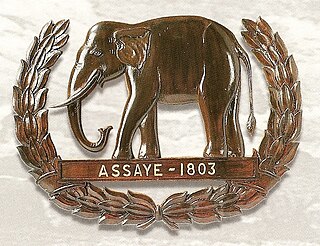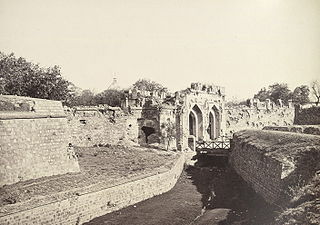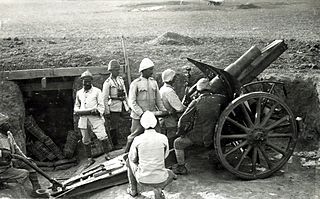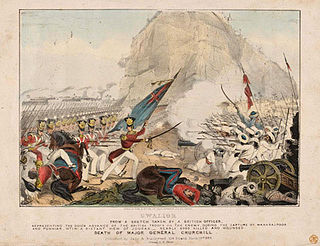 W
WThe Indian Army has a distinguished history in which they won many battle and theatre honours. The practice of giving battle honours began with the East India Company who awarded these to the units of the native Indian corps in their presidency armies. The practice continued after the advent of the British Crown post-1857 when the armies of the East India Company became part of the British Indian Army and after India's independence in 1947. The earliest conflict for which a battle honour was awarded was "Plassey" which was awarded in 1829 to the 1st Regiment, Bengal Native Infantry which served the East India Company in Bengal while the latest is "Kargil" in 1999 awarded to units of independent India's army for feats during the Kargil War.
 W
WThe Government of India has declared repugnant some battle honours earned by Indian Army units, which are descended from erstwhile units of the East India Company. Indian Army units do not inscribe these battle honours on their colours and do not celebrate commemoration days associated with these battles. This decision was taken post-independence regarding those battle honours concerned with battles in India and Pakistan which the Indian government regards as part of the "subjugation" of India and in some cases, neighbouring countries.
 W
WAbyssinia is a battle honour awarded to units of the British Indian Army and the British Army which participated in the 1868 campaign to free Europeans held hostage in Abyssinia by Emperor Tewodros II. The success of the expedition led to the award of this honour to units of the British Indian Army which had participated in the campaign. The units belonged, with the exception of the Madras Sappers, to the Bengal and Bombay Presidency Armies.
 W
WThe First Anglo-Afghan War was fought between the British Empire and the Emirate of Afghanistan from 1839 to 1842. Initially, the British successfully intervened in a succession dispute between emir Dost Mohammad (Barakzai) and former emir Shah Shujah (Durrani), whom they installed upon conquering Kabul in August 1839. The main British Indian force occupying Kabul along with their camp followers, having endured harsh winters as well, was almost completely annihilated during its 1842 retreat from Kabul. The British then sent an Army of Retribution to Kabul to avenge their defeat, and having demolished parts of the capital and recovered prisoners they left Afghanistan altogether by the end of the year. Dost Mohamed returned from exile in India to resume his rule.
 W
WThe Anglo–Persian War lasted between November 1, 1856 and April 4, 1857 and was fought between the British Empire and Iran (Persia), then ruled by the Qajar dynasty. The war had the British oppose an attempt by Iran to press its claim on the city of Herat. Though Herat had been part of Iran under the Qajar dynasty when the war broke out, it had declared itself independent under its own rebellious emir and placed itself under the protection of the British in India and in alliance with the Emirate of Kabul, the predecessor of the modern state of Afghanistan. The British campaign was successfully conducted under the leadership of Major General Sir James Outram in two theatres: on the southern coast of Iran near Bushehr and in southern Mesopotamia.
 W
WThe Assaye battle honour was awarded by the Governor General of British India to all East India Company battalions and British Army regiments that took part of the Battle of Assaye. The battle occurred on 23 September 1803, near the village of Assaye in western India where a small force under the command of Major General Arthur Wellesley defeated a 50,000 strong army of the Maratha Confederacy. The British and native troops were awarded the battle honour Assaye with the device of Elephant vide General Order of Governor General dated 30 October 1803. The British regiments and Madras battalions involved were also presented with an honorary colour to mark their achievement. The Madras Battalions celebrated the victory for over a century till their disbandment in the 1920s.
 W
WThe Anglo–Persian War lasted between November 1, 1856 and April 4, 1857 and was fought between the British Empire and Iran (Persia), then ruled by the Qajar dynasty. The war had the British oppose an attempt by Iran to press its claim on the city of Herat. Though Herat had been part of Iran under the Qajar dynasty when the war broke out, it had declared itself independent under its own rebellious emir and placed itself under the protection of the British in India and in alliance with the Emirate of Kabul, the predecessor of the modern state of Afghanistan. The British campaign was successfully conducted under the leadership of Major General Sir James Outram in two theatres: on the southern coast of Iran near Bushehr and in southern Mesopotamia.
 W
WThe concurrent Battle of Meiktila and Battle of Mandalay were decisive engagements near the end of the Burma Campaign. Collectively, they are sometimes referred to as the Battle of Central Burma. Despite logistical difficulties, the Allies were able to deploy large armoured and mechanised forces in Central Burma, and also possessed air supremacy. Most of the Japanese forces in Burma were destroyed during the battles, allowing the Allies to later recapture the capital, Rangoon, and reoccupy most of the country with little organised opposition.
 W
WThe Siege of Arrah took place during the Indian Mutiny. It was the eight-day defence of a fortified outbuilding, occupied by a combination of 18 civilians and 50 members of the Bengal Military Police Battalion, against 2,500–3,000 mutinying Bengal Native Infantry sepoys from three regiments and an estimated 8,000 men from irregular forces commanded by Kunwar Singh, the local zamindar or chieftain who controlled the Jagdishpur estate.
 W
WThe Siege of Lucknow was the prolonged defence of the Residency within the city of Lucknow during the Indian Rebellion of 1857. After two successive relief attempts had reached the city, the defenders and civilians were evacuated from the Residency, which was then abandoned.
 W
WThe concurrent Battle of Meiktila and Battle of Mandalay were decisive engagements near the end of the Burma Campaign. Collectively, they are sometimes referred to as the Battle of Central Burma. Despite logistical difficulties, the Allies were able to deploy large armoured and mechanised forces in Central Burma, and also possessed air supremacy. Most of the Japanese forces in Burma were destroyed during the battles, allowing the Allies to later recapture the capital, Rangoon, and reoccupy most of the country with little organised opposition.
 W
WThe Siege of Delhi was one of the decisive conflicts of the Indian rebellion of 1857.
 W
WThe Anglo–Persian War lasted between November 1, 1856 and April 4, 1857 and was fought between the British Empire and Iran (Persia), then ruled by the Qajar dynasty. The war had the British oppose an attempt by Iran to press its claim on the city of Herat. Though Herat had been part of Iran under the Qajar dynasty when the war broke out, it had declared itself independent under its own rebellious emir and placed itself under the protection of the British in India and in alliance with the Emirate of Kabul, the predecessor of the modern state of Afghanistan. The British campaign was successfully conducted under the leadership of Major General Sir James Outram in two theatres: on the southern coast of Iran near Bushehr and in southern Mesopotamia.
 W
WKyaukmyaung is a town in Sagaing Division, Myanmar. It is situated 46 miles north of Mandalay on the west bank of the River Irrawaddy, and 17 miles east of Shwebo by road. It marks the end of the third defile of the Irrawaddy.
 W
WThe Mesopotamian campaign was a campaign in the Middle Eastern theatre of World War I fought between the Allies represented by the British Empire, troops from Britain, Australia and the vast majority from British India, against the Central Powers, mostly from the Ottoman Empire.
 W
WThe battle honour of Mysore commemorates the action of native units of the British East India Company in the Third Anglo-Mysore War of 1789–92.
 W
WThe Sinai and Palestine campaign of the Middle Eastern theatre of World War I was fought by the Arab Revolt and the British Empire, against the Ottoman Empire and its Imperial German allies. It started with an Ottoman attempt at raiding the Suez Canal in 1915, and ended with the Armistice of Mudros in 1918, leading to the cession of Ottoman Syria.
 W
WThe Anglo–Persian War lasted between November 1, 1856 and April 4, 1857 and was fought between the British Empire and Iran (Persia), then ruled by the Qajar dynasty. The war had the British oppose an attempt by Iran to press its claim on the city of Herat. Though Herat had been part of Iran under the Qajar dynasty when the war broke out, it had declared itself independent under its own rebellious emir and placed itself under the protection of the British in India and in alliance with the Emirate of Kabul, the predecessor of the modern state of Afghanistan. The British campaign was successfully conducted under the leadership of Major General Sir James Outram in two theatres: on the southern coast of Iran near Bushehr and in southern Mesopotamia.
 W
WThe Second Anglo-Sikh War was a military conflict between the Sikh Empire and the British East India Company that took place in 1848 and 1849. It resulted in the fall of the Sikh Empire, and the annexation of the Punjab and what subsequently became the North-West Frontier Province, by the East India Company.
 W
WThe Second Anglo-Sikh War was a military conflict between the Sikh Empire and the British East India Company that took place in 1848 and 1849. It resulted in the fall of the Sikh Empire, and the annexation of the Punjab and what subsequently became the North-West Frontier Province, by the East India Company.
 W
WThe Gwalior Campaign was fought between British and Maratha forces in Gwalior in India, December 1843.
 W
WThe Anglo–Persian War lasted between November 1, 1856 and April 4, 1857 and was fought between the British Empire and Iran (Persia), then ruled by the Qajar dynasty. The war had the British oppose an attempt by Iran to press its claim on the city of Herat. Though Herat had been part of Iran under the Qajar dynasty when the war broke out, it had declared itself independent under its own rebellious emir and placed itself under the protection of the British in India and in alliance with the Emirate of Kabul, the predecessor of the modern state of Afghanistan. The British campaign was successfully conducted under the leadership of Major General Sir James Outram in two theatres: on the southern coast of Iran near Bushehr and in southern Mesopotamia.